Using This Guide
The NEC MobilePro™ 800 User's Guide gives you the
information you need to maximize the use of your NEC
MobilePro 800 Professional PC Companion. Read this guide
to familiarize yourself with the MobilePro and its features.
For specific information, see the following.
T Chapter 1, “Getting Started,” provides all the information
you need to get your MobilePro 800 working and
synchronized with your host PC.
T Chapter 2, “Introducing the NEC MobilePro,” introduces
you to the MobilePro features, battery recharging, and
general unit care.
T Chapter 3, “Introducing Windows CE,” provides an
overview of Microsoft® Windows® CE and Windows CE
applications.
T Chapter 4, “Using the NEC MobilePro,” shows you how
to power on and off, make display panel adjustments,
install PC and CompactFlash™ cards, and more.
T Chapter 5, “Setting Up a Remote Connection,” describes
how to configure service connections for an internet
service provider, a remote access service, and how to
configure email for each new service connection.
T Appendix A, “Troubleshooting,” walks you through some
common problems and possible solutions.
T Appendix B, “Specifications,” details the hardware
specifications for your MobilePro.
T Appendix C, “ISP Settings,” provides selected ISP settings
for a variety of internet service providers.
Using This Guide vii
�
T Appendix D, “Microsoft Windows CE Services,” provides
additional information about installing and using Windows
CE Services.
Text Conventions
To make this guide as easy to use as possible, text is set up as
follows.
T Warnings, cautions, and notes have the following format:
! WARNING
Warnings alert you to situations that could result
in serious personal injury or loss of life.
! CAUTION
Cautions indicate situations that can damage the
system hardware or software.
Note: Notes give particularly important
information about whatever is being described.
T Names of keys are printed as they appear on the keyboard,
for example, Ctrl, Alt, or Enter.
T Text that you must type or keys that you must press are
presented in bold type. For example, type dir and press
Enter.
viii Using This Guide
�
Proprietary Notice and Liability Disclaimer
The information disclosed in this document, including all designs and
related materials, is the valuable property of NEC Computer Systems
Division, Packard Bell NEC, Inc. (hereinafter “NEC CSD”) and/or its
licensors. NEC CSD and/or its licensors, as appropriate, reserve all patent,
copyright and other proprietary rights to this document, including all
design, manufacturing, reproduction, use, and sales rights thereto, except to
the extent said rights are expressly granted to others.
The NEC CSD product(s) discussed in this document are warranted in
accordance with the terms of the Warranty Statement accompanying each
product. However, actual performance of each such product is dependent
upon factors such as system configuration, customer data, and operator
control. Since implementation by customers of each product may vary, the
suitability of specific product configurations and applications must be
determined by the customer and is not warranted by NEC CSD.
To allow for design and specification improvements, the information in this
document is subject to change at any time, without notice. Reproduction of
this document or portions thereof without prior written approval of
NEC CSD is prohibited.
NEC is a registered trademark of NEC Corporation, MobilePro is a registered trademark of
Packard Bell NEC Inc., used under license.
Microsoft, MS, MSN, PowerPoint, ActiveX, ActiveSync, Outlook, Windows, Windows NT,
Visual Basic, Visual C++, and the Windows logo are either registered trademarks or
trademarks of Microsoft Corporation in the United States and/or other countries.
Microsoft products are licensed to OEMs by Microsoft Licensing, Inc., a wholly owned
subsidiary of Microsoft Corporation.
All other product, brand, or trade names used in this publication are the trademarks or
registered trademarks of their respective trademark owners.
First Printing — February 1999
Copyright 1999
NEC Computer Systems Division
Packard Bell NEC, Inc.
1 Packard Bell Way
Sacramento, CA 95828-0903
All Rights Reserved
�
Index
A
AC power port, 2-8
Accessing MobilePro settings,
4-14
Accessories, 1-4, B-4
Adjusting MobilePro settings,
4-12
Adjusting panel brightness, 4-4
Assigning user software icons,
4-13
Auto Suspend, 4-6
Available options, B-4
B
Backing up and restoring data,
3-11
Backlight settings, 4-4
Battery
determining status, 2-12
installing and charging, 1-4
precautions, 2-17
recharging, 2-12
removing and inserting, 2-14
replacement, 2-14
Battery pack, 2-6
Battery release latch, 2-10
Bonus CD
software applications, 3-13
Bonus Software CD
using, 3-14
using with Windows NT, 3-15
C
Caring for the MobilePro, 2-18
CompactFlash card slot, 2-9
CompactFlash cards
inserting, 4-19
removing, 4-20
Connecting
activate a connection, 5-8
internet service provider (ISP),
5-4
modem, 5-3
preparation, 5-2
remote access server (RAS),
5-5
Connecting the AC adapter, 1-7
Connecting the PC Connect
cable, 1-13
Connecting the VGA cable, 3-7
Connecting to your PC, 1-9
Creating a partnership, 1-14
D
Determining battery status, 2-12
Display panel, 2-3
Docking cradle connector, 2-10
E
Earphone microphone jack, 2-8
Enabling the suspend switch, 4-6
F
Features
AC power port, 2-8
battery release latch, 2-10
CompactFlash card slot, 2-9
display panel, 2-4
display panel icons, 2-4
display panel latch, 2-4
docking cradle connector, 2-10
Index-1
�
earphone microphone, 2-8
IR port, 2-7
Kensington lock, 2-9
keyboard, 2-5
Lithium-Ion battery, 2-10
main battery pack, 2-6
microphone, 2-6
modem port, 2-9
PC card eject button, 2-8
PC card slot, 2-8
power button, 2-5
ROM/RAM bay cover, 2-10
serial port, 2-7
speaker, 2-6
status LEDs, 2-6
stylus, 2-6
stylus slot, 2-9
Suspend switch, 2-5
USB port, 2-7
user software icons, 2-4
VGA port, 2-7
Full reset button, 4-24
using, 4-26
Function keys, 4-11
G
Getting help, 1-18
I
Inserting CompactFlash cards,
4-19
Inserting PC cards, 4-17
Installing Windows CE Services,
1-11
with Windows NT, 1-11
IR port, 2-7
ISP settings
AT&T WorldNet, C-2
CompuServe, C-2
Index-2
IBM, C-3
MSN, C-3
overview, C-1
Prodigy, C-4
K
Kensington lock, 2-9
Keyboard, 2-5
application shortcut keys, 4-8
brightness keys, 4-8
control keys, 4-9
cursor control keys, 4-9
using, 4-8
Windows key, 4-9
L
Lithium-Ion battery, 2-10
M
Main battery pack, 2-6
Microphone, 2-6
Microsoft Windows CE Services,
D-1
MobilePro power management,
2-13
MobilePro settings, 4-12
Modem port, 2-9
N
NEC CSD support services, A-3
Network capabilities, 3-10
O
Online help, 3-15
Opening the display panel, 2-11
P
Panel brightness, 4-4
PC card eject button, 2-8
PC card slot, 2-8
�
PC cards
inserting, 4-17
removing, 4-17
PC Connect cable
when using other
communication devices, 1-17
Pocket applications, 3-6
Power button, 2-5
Precautions, 2-18
Printing, 3-9
Problem solving, A-1
R
Remote synchronization, D-4
Removing CompactFlash cards,
4-20
Removing PC cards, 4-17
Reset button
full reset, 4-24
soft reset, 4-24
Resetting the MobilePro, 4-24
Resynchronizing your MobilePro,
1-16
ROM/RAM bay cover, 2-10
Routine cleaning, 2-20
S
Sending and receiving email, 5-6
Serial port, 2-7
Setting up a remote connection,
1-17
Soft reset button, 4-24
using, 4-25
Software applications, 3-13
Speaker, 2-6
Specifications
accessories (shipped with
system), B-3
battery, B-3
CompactFlash card slot, B-3
CPU, B-1
dimensions, B-4
display panel, B-1
I/O ports, B-2
infrared (IR) port, B-2
microphone, B-1
modem, B-2
operating environment, B-4
PC card slot, B-2
RAM, B-1
ROM, B-1
serial, B-2
speaker, B-2
storage environment, B-4
weight, B-4
Status LEDs, 2-6
Storage requirements, 2-19
Stylus, 2-6
Stylus slot, 2-9
Suspend, 4-6
Suspend switch, 2-5
Synchronizing files, D-3
Synchronizing your MobilePro
after rebooting the host PC,
1-16
after resetting, 1-16
System features
back, 2-7
bottom, 2-10
front, 2-3
keyboard panel and base unit,
2-5
left, 2-8
right, 2-9
T
Troubleshooting, A-1
Index-3
�
U
Unpacking your MobilePro, 2-2
Upgrading ROM, 4-22
USB port, 2-7
User software icons, 4-13
Using application shortcut keys,
4-9
Using MobilePro power sources,
2-12
Using the infrared (IR) port, 4-20
Using the IR port
Windows CE Services, 4-20
Using the stylus, 2-11
Using the voice recorder, 4-15
Using Windows CE, 3-2
V
Verifying PC connection settings,
1-10
Verifying synchronization
settings, 1-15
VGA port, 2-7
Voice memos, 4-15
Voice recording, 4-15
W
Windows CE
applications, 3-6
backing up and restoring data,
3-11
network capabilities, 3-10
overview, 3-2
printing, 3-9
Windows CE desktop, 3-4
Windows CE operating system,
3-2
Windows CE services, 3-10
Index-4
�
1
Getting Started
T Welcome
T Getting to Know Your MobilePro
T Installing and Charging the Battery
T Connecting the AC Adapter
T Taking a Quick Tour
T Knowing Your MobilePro Software
T Connecting to Your PC
T Synchronizing with your Host PC
T Setting Up a Remote Connection
T Getting Help
�
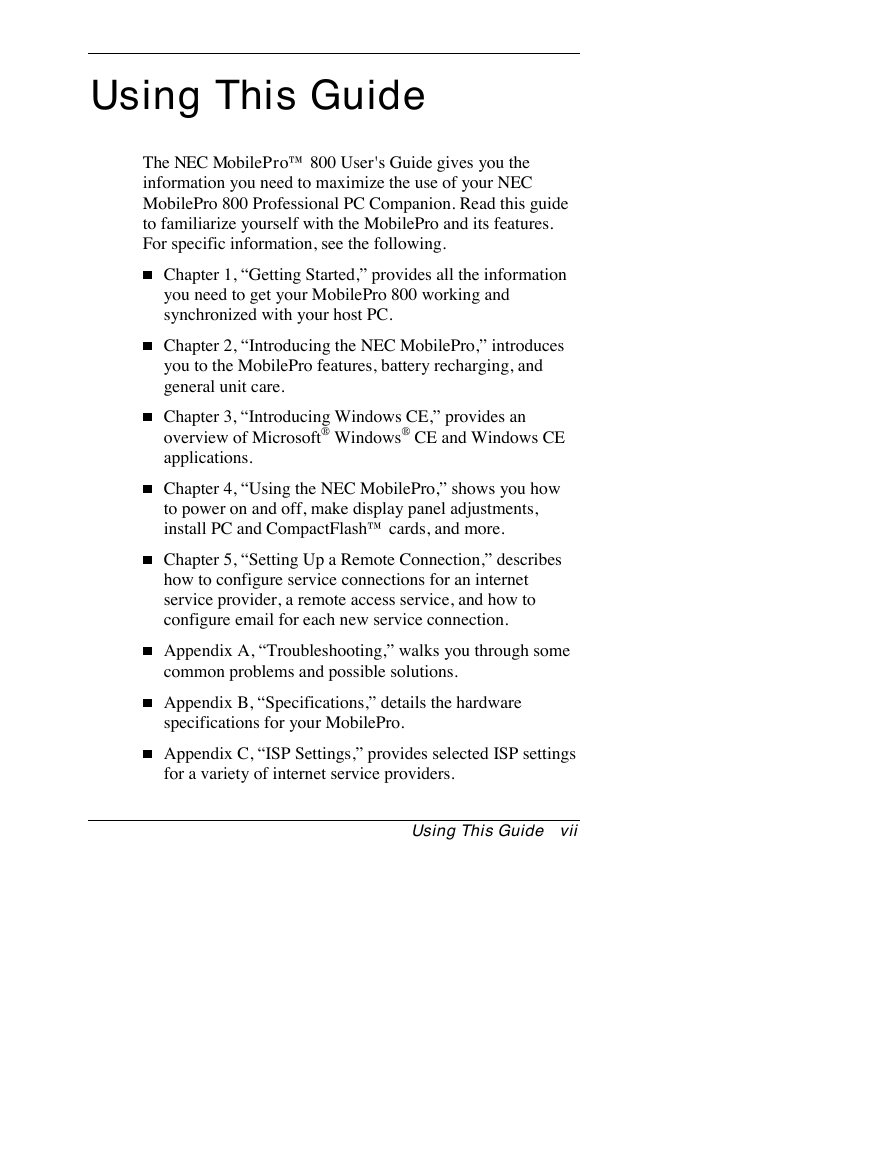
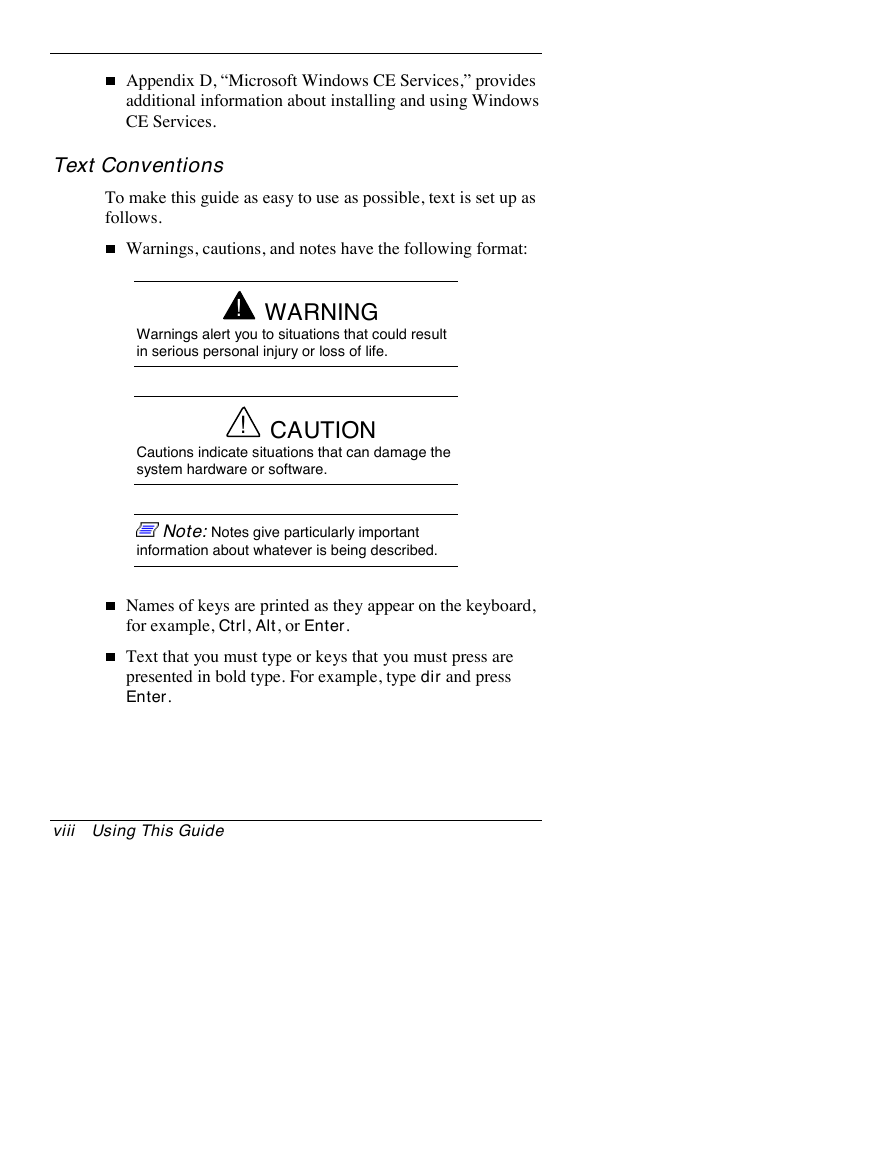
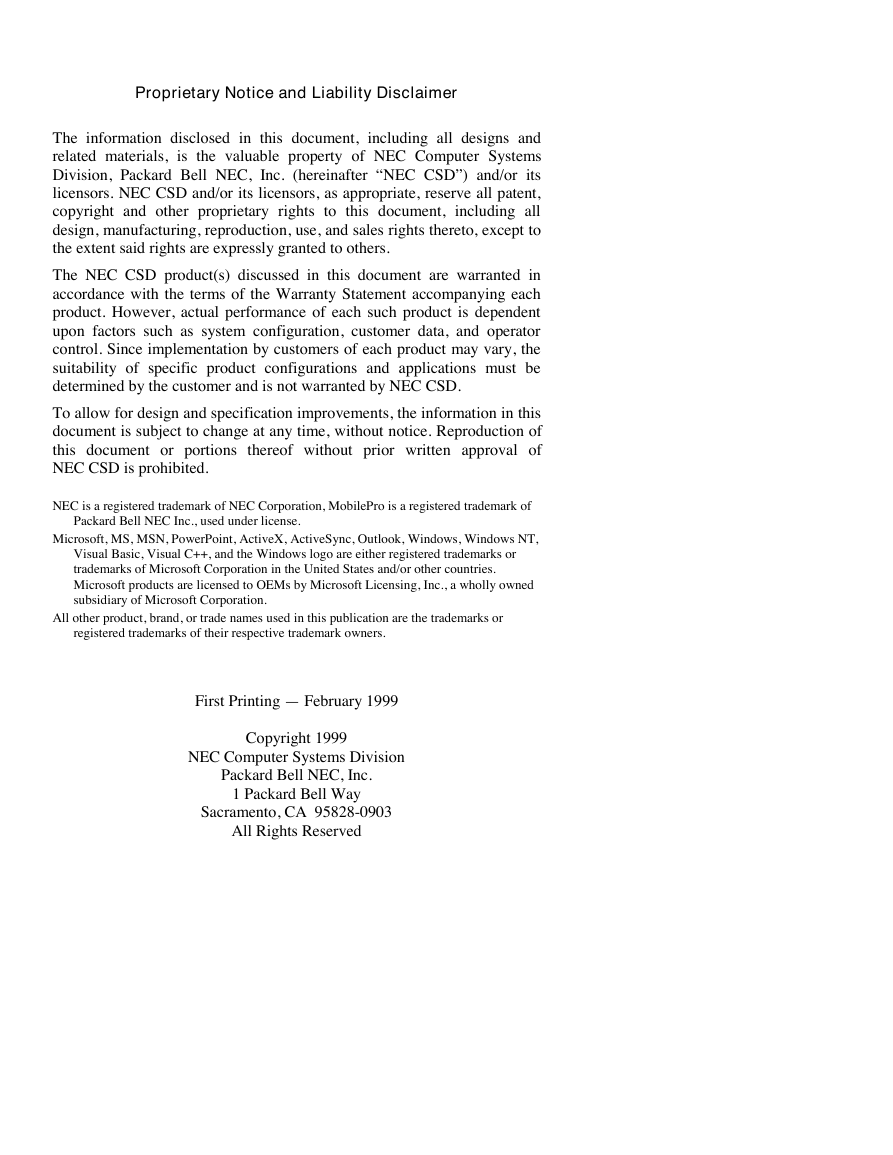
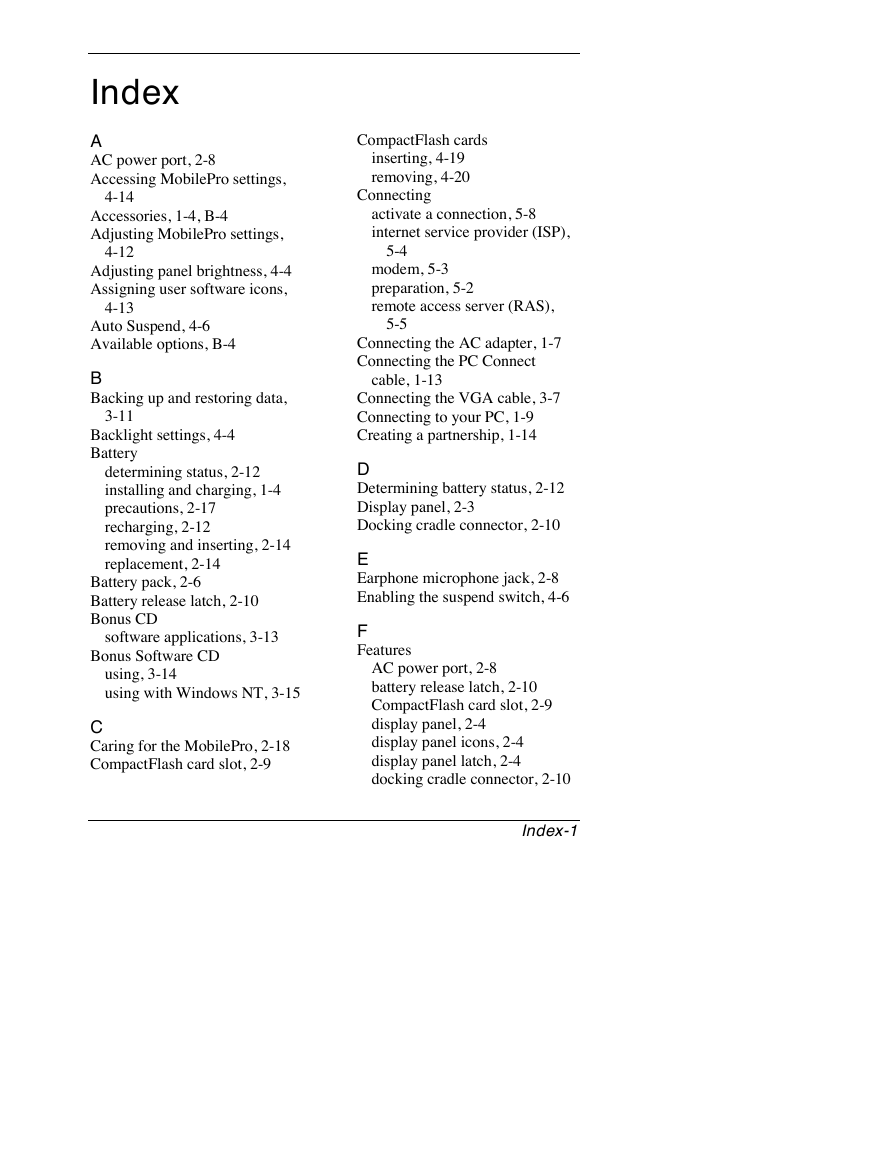
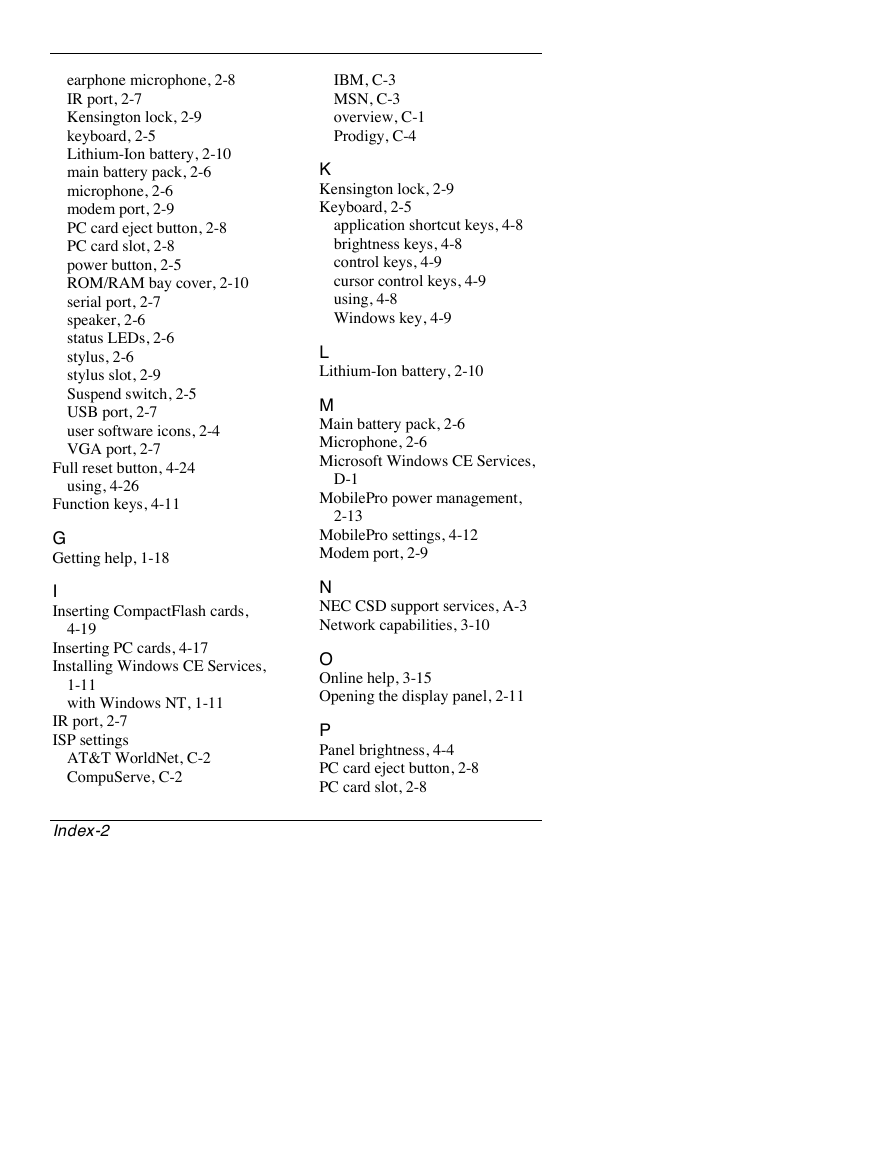

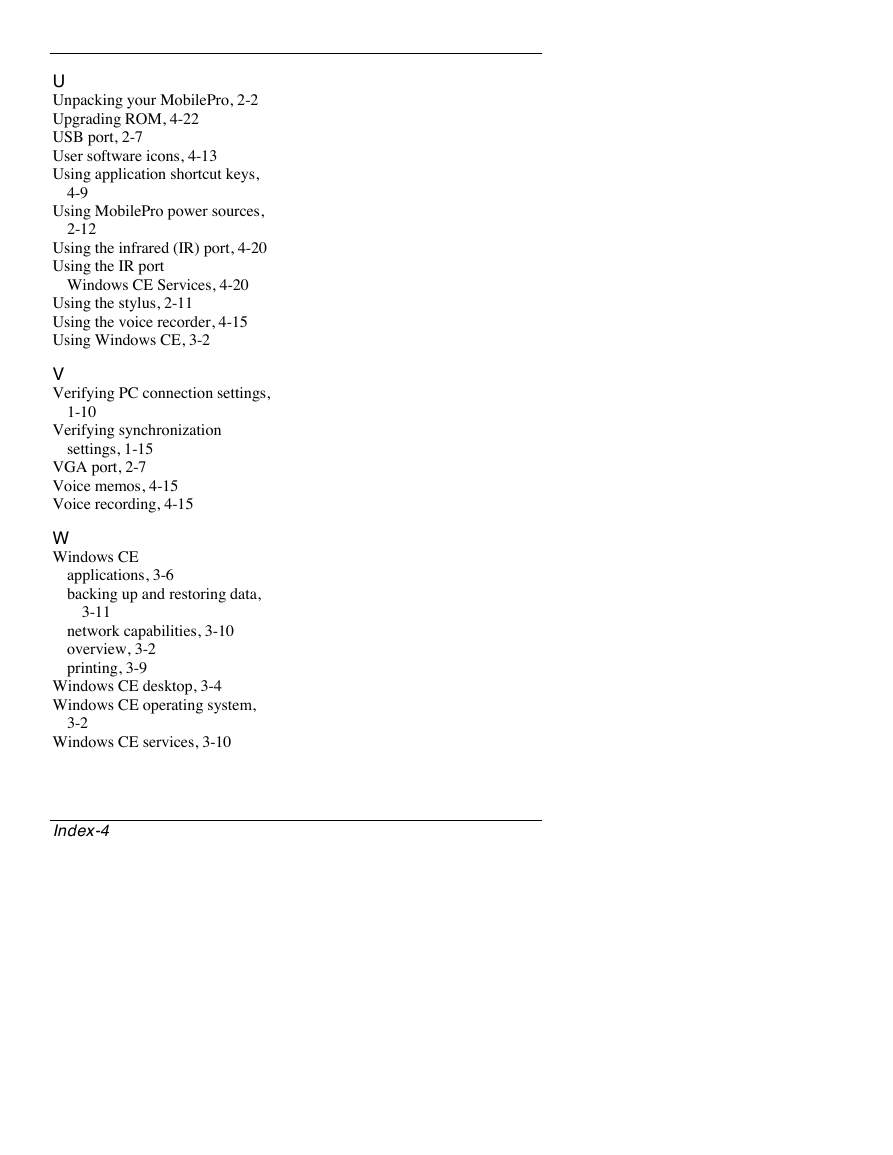
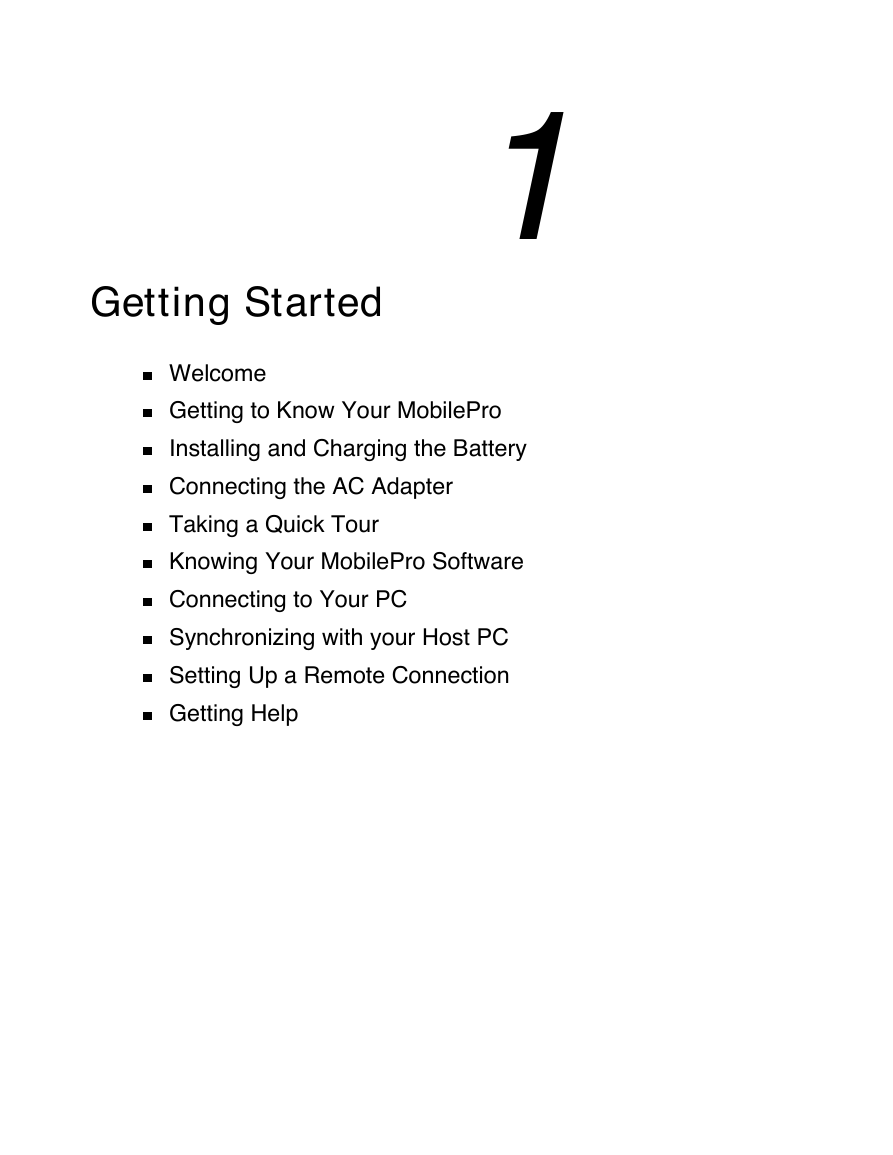








 2023年江西萍乡中考道德与法治真题及答案.doc
2023年江西萍乡中考道德与法治真题及答案.doc 2012年重庆南川中考生物真题及答案.doc
2012年重庆南川中考生物真题及答案.doc 2013年江西师范大学地理学综合及文艺理论基础考研真题.doc
2013年江西师范大学地理学综合及文艺理论基础考研真题.doc 2020年四川甘孜小升初语文真题及答案I卷.doc
2020年四川甘孜小升初语文真题及答案I卷.doc 2020年注册岩土工程师专业基础考试真题及答案.doc
2020年注册岩土工程师专业基础考试真题及答案.doc 2023-2024学年福建省厦门市九年级上学期数学月考试题及答案.doc
2023-2024学年福建省厦门市九年级上学期数学月考试题及答案.doc 2021-2022学年辽宁省沈阳市大东区九年级上学期语文期末试题及答案.doc
2021-2022学年辽宁省沈阳市大东区九年级上学期语文期末试题及答案.doc 2022-2023学年北京东城区初三第一学期物理期末试卷及答案.doc
2022-2023学年北京东城区初三第一学期物理期末试卷及答案.doc 2018上半年江西教师资格初中地理学科知识与教学能力真题及答案.doc
2018上半年江西教师资格初中地理学科知识与教学能力真题及答案.doc 2012年河北国家公务员申论考试真题及答案-省级.doc
2012年河北国家公务员申论考试真题及答案-省级.doc 2020-2021学年江苏省扬州市江都区邵樊片九年级上学期数学第一次质量检测试题及答案.doc
2020-2021学年江苏省扬州市江都区邵樊片九年级上学期数学第一次质量检测试题及答案.doc 2022下半年黑龙江教师资格证中学综合素质真题及答案.doc
2022下半年黑龙江教师资格证中学综合素质真题及答案.doc